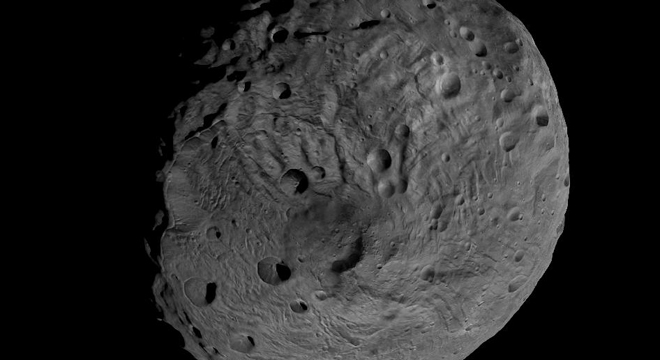Can the final frontier become more like the old mining frontier? That’s at least that’s the ambitious plan of a new company called Planetary Resources, which seeks to eventually use robotic spacecraft to locate and mine asteroids in the nearby solar system.
The company was co-founded three years ago by Peter Diamandis and Eric Anderson, billionaire entrepreneurs with experience developing or facilitating the development of private space travel systems — Diamandis through his Ansari X Prize competition and Anderson through his company, Space Adventures, which flies wealthy clients into low-earth orbit.
But after operating in relative silence since its inception, Planetary Resources has in the past few days been leaking details of its out-of-this-world quest for platinum and other resources on asteroids. The company is today set to announce in greater detail its plans for asteroid mining at an event held at the The Museum of Flight in Seattle at 1:30 pm ET. It will be livestreamed on the website of Planetary Resources.
So far, what’s known is that the company’s other high-profile billionaire investors and advisors include Larry Page and Sergey Brin, co-founders of Google, and James Cameron, Hollywood director and deep sea explorer.
The company, based out of Washington state, plans to first launch telescopes into earth’s orbit that will identify asteroids with enough of valuable resources to make mining them worthwhile, then send up robotic probes to visit and map the asteroids, and finally others equipped with drills that will be able to retrieve minerals.
The actual timeline for the project isn’t hard and fast, with Planetary Resources set to launch between two and five orbital telescopes in the next 18 to 24 months, the initial mapping probes in five to seven and mining coming at a still unspecified time, according to WIRED.
Still, it’s not the technical hurdles that are the most challenging in Planetary Resources’ quest, but rather the completely uncharted legal territory it will enter into as it progresses along its plan.
“Can it be done? Sure,” said Henry Hertzfeld, a professor of space policy and international affairs at George Washington University in Washinton, D.C., in a telephone interview with TPM. “Is there anything illegal about what they’ve proposed? No. But the devil is in the details. There are alot of unknown hurdles — national regulatory issues and possibly international.”
Joanne Gabrynowicz, director of the National Center for Remote Sensing, Air and Space Law and a professor of space law at University of Mississippi, agreed, telling TPM in a phone interview: “There are a lot of unknowns here and a lot of open questions that will be determined if they continue to progress in their plans.”
What is known for certain is that despite the fact that Planetary Resources is a private venture, the U.S. government will ultimately be responsible for “supervising” their space mining operations.
That’s because the U.S. is bound by the terms of the 1967 Outer Space Treaty, an international agreement that essentially recognizes space as a global commons, similar in some respects to the deep oceans and ocean bed. It includes 101 parties.
According to article six of the treaty: “The activities of non-governmental entities in outer space, including the Moon and other celestial bodies, shall require authorization and continuing supervision by the appropriate State Party to the Treaty. ”
What “supervision” means in the context of asteroid mining still has yet to be determined, but based on the way that the U.S. oversees current private or quasi-private space activities, including launches and remote sensory activities, Gabrynowicz told TPM that she believes Planetary Resources will need to be granted a license by the U.S. government in order to actually mine anything in space.
“They will probably need to get a license,” Gabrynowicz said, “But we don’t know yet what it will look like or authorize, because the terms haven’t been determined.”
That said, Gabrynowicz, like Hertzfeld, said that she believed that Planetary Resources was legally clear to mine asteroids under the Outer Space Treaty.
“I don’t see anything in the Outer Space Treaty that would prevent these types of activities,” Gabrynowicz told TPM.
However, both Gabrynowicz and Hertzfeld cautioned that the issue of legal liability for any space mining activities gone awry was an outstanding one that would need to be addressed if Planetary Resources’ plans were to come to fruition.
“If something goes wrong and a company does damage to the property of another nation, and that can be a satellite or spacecraft, or if something falls back to Earth, it’s the supervising nation that has to write the check to pay for it, in this case, the U.S.,” Hertzfeld told TPM, pointing to Article 7 of the Outer Space Treaty.
However, in practice, private space launching companies currently have insurance agreements with the U.S. government to pay a certain amount of money in the case of damages, and after that the U.S. kicks in its own indemnification payments.
“As for mining and in orbit activities such as this company is proposing, we don’t know how it would go,” Hertzfeld told TPM.
But could Planetary Resources be sued for even embarking upon its mining operations in the first place, as it is proposing to take resources away from a global commons?
“That’s the speculation,” Gabrynowicz told TPM, “But a lawsuit requires specific facts, and right now, any of those facts can change, so I’m not going to speculate.”






